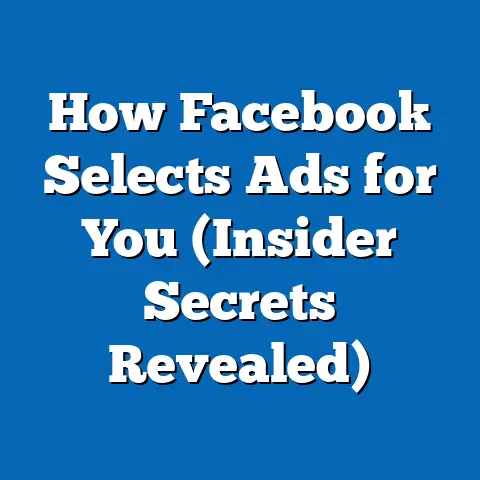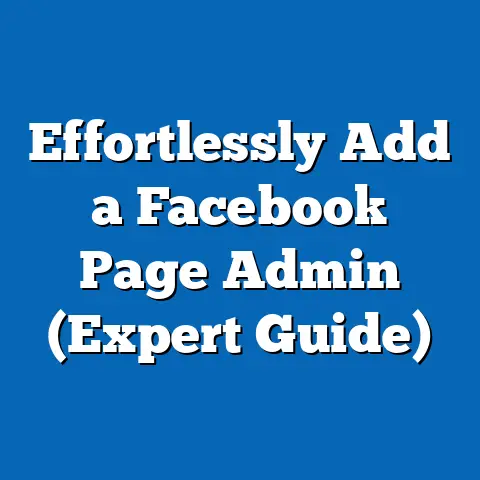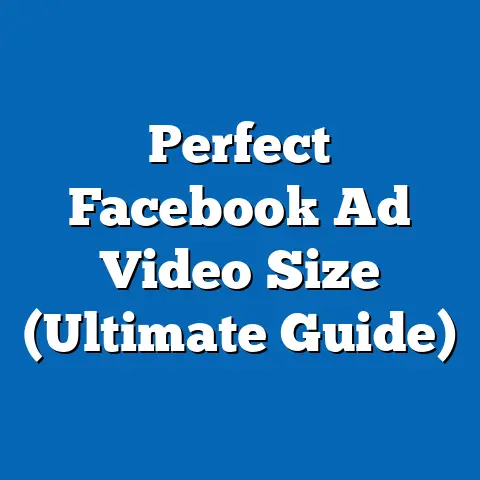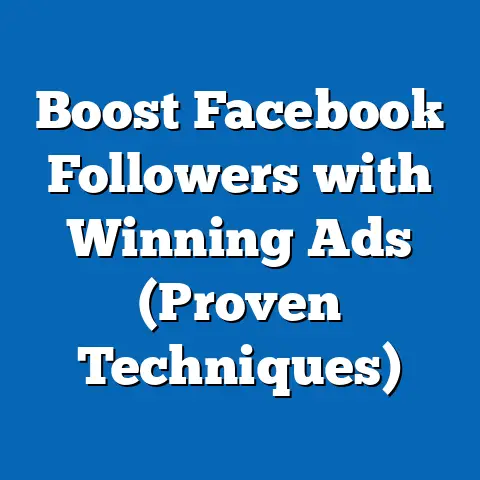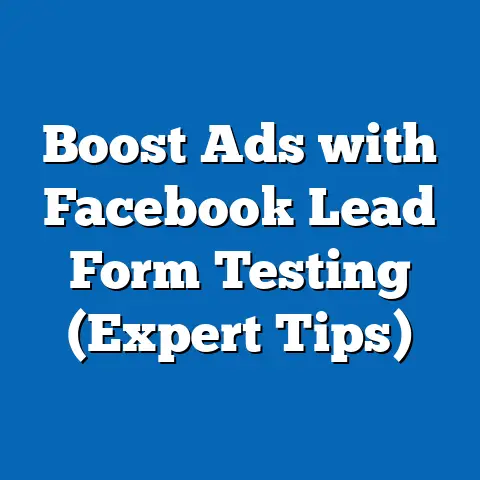Boost Engagement with In-Video Facebook Ads (Pro Strategy)
Advertising has come a long way, hasn’t it? I remember flipping through magazines as a kid, mesmerized by the glossy print ads, or craning my neck to catch a glimpse of a billboard on a family road trip. And who could forget the catchy jingles and elaborate storylines of television commercials? These traditional methods – print ads, billboards, and TV spots – really laid the foundation for what we now understand as marketing. They taught us about grabbing attention, building brand awareness, and ultimately, driving sales.
But times have changed. We’ve shifted from passively consuming static ads to actively engaging with dynamic, interactive content. And that’s where in-video advertising on Facebook comes in. It’s the next frontier, a powerful way to connect with your audience in a way that feels less like an interruption and more like an experience. Consumer behavior has drastically evolved; audiences now crave visually compelling content over traditional advertising formats. They’re looking for stories, experiences, and something that resonates with them on a personal level. In-video ads, when done right, can deliver exactly that.
Understanding In-Video Facebook Ads
So, what exactly are in-video Facebook ads? Simply put, they are advertisements that appear within video content on the Facebook platform. Think of it like this: you’re scrolling through your newsfeed, watching a funny cat video, and then an ad seamlessly plays before, during, or after that video. The beauty of in-video ads is their ability to capture attention in a format that people already enjoy – watching videos!
Facebook offers several formats for in-video ads, each with its own unique placement and characteristics:
- In-Stream Ads: These are short video ads that play before, during, or after other video content. They are typically skippable after a few seconds, so it’s crucial to grab the viewer’s attention quickly.
- Branded Content: This involves partnering with influencers or creators to produce video content that promotes your brand in an authentic way. It’s a great way to reach a new audience and build trust.
- Ad Breaks in Live Broadcasts: These are short ads that appear during live video broadcasts. They can be a powerful way to reach a highly engaged audience in real-time.
I’ve seen firsthand how effective video content can be. I once worked with a local bakery that was struggling to get the word out about their new line of gluten-free products. We created a short, mouth-watering video showcasing the baking process and highlighting the delicious taste and texture of the gluten-free treats. We ran it as an in-stream ad targeting people with gluten sensitivities and those interested in healthy eating. The results were incredible! The bakery saw a significant increase in website traffic and in-store sales, and they even received several orders for custom gluten-free cakes.
According to recent statistics, video content is incredibly effective in engaging users. A study by HubSpot found that 54% of consumers want to see more video content from a brand or business they support. Furthermore, video ads have a higher click-through rate than static image ads. These numbers speak volumes!
Different types of businesses can benefit from in-video ads. Let’s break it down:
- E-commerce: Showcase your products in action with engaging product demos or customer testimonials.
- Services: Explain your services and how they can solve customer problems through explainer videos or behind-the-scenes footage.
- Entertainment: Promote your movies, music, or events with trailers, music videos, or behind-the-scenes interviews.
Key Takeaway: In-video Facebook ads are a dynamic way to reach your target audience and engage them with compelling video content. Understanding the different formats available and leveraging the power of video can significantly boost your marketing efforts.
Crafting Compelling Video Content
Creating a compelling video ad is more than just pointing a camera and hitting record. It’s about telling a story, evoking emotion, and delivering a clear message in a visually appealing way.
Here are a few key elements that make a video ad truly stand out:
- Storytelling: People connect with stories. Craft a narrative that resonates with your target audience, highlighting their pain points and showcasing how your product or service can solve them.
- Emotional Appeal: Tap into the emotions of your viewers. Whether it’s humor, inspiration, or nostalgia, emotional connections can make your video more memorable and impactful.
- Clear Messaging: Get straight to the point. Communicate your key message clearly and concisely within the first few seconds of the video.
- High-Quality Visuals: Invest in professional-quality visuals. Use high-resolution footage, eye-catching graphics, and creative animations to capture attention.
- Sound Design: Don’t underestimate the power of sound. Use clear audio, engaging music, and sound effects to enhance the viewing experience.
- Branding Elements: Incorporate your brand logo, colors, and fonts seamlessly into the video. This helps reinforce brand recognition and build brand identity.
I’ve learned that the first few seconds of a video are absolutely crucial. You have a very limited window of opportunity to capture the viewer’s attention and convince them to keep watching. Start with a visually striking image, a thought-provoking question, or a captivating hook that immediately grabs their interest.
For example, if you’re advertising a travel agency, you might start with a breathtaking shot of a tropical beach or a bustling city skyline. If you’re promoting a new fitness program, you might show a before-and-after transformation or a high-energy workout scene. The key is to make a strong impression right from the start.
Captions and subtitles are also essential. Many people watch videos on mute, especially when they’re in public places. Adding captions or subtitles ensures that your message is still conveyed even if the audio is turned off. It also makes your videos accessible to a wider audience, including those who are deaf or hard of hearing.
Key Takeaway: Crafting compelling video content requires a blend of creativity, strategy, and technical expertise. By focusing on storytelling, emotional appeal, clear messaging, and high-quality visuals, you can create videos that capture attention, engage viewers, and drive results.
Targeting the Right Audience
You can have the most amazing video in the world, but if you’re showing it to the wrong people, it’s not going to be effective. That’s why audience targeting is so important. It’s about reaching the people who are most likely to be interested in your product or service.
Facebook offers a wide range of targeting options that allow you to narrow down your audience based on:
- Demographics: Age, gender, location, education, and more.
- Interests: Hobbies, activities, and topics that people are interested in.
- Behaviors: Online activities, purchase history, and other behaviors.
- Custom Audiences: Upload your own customer data (email addresses, phone numbers) to create targeted audiences.
- Lookalike Audiences: Find new customers who are similar to your existing customers.
I’ve found that effective audience segmentation strategies can significantly enhance the performance of in-video ads. For example, if you’re selling a product that’s targeted towards millennials, you might create a separate ad campaign specifically for that demographic. You can then tailor the video content and messaging to resonate with their specific interests and values.
Understanding your target audience’s preferences and behaviors is crucial. What are their pain points? What are their aspirations? What kind of content do they enjoy? By answering these questions, you can create videos that are relevant, engaging, and persuasive.
I once worked with a clothing brand that was targeting college students. We conducted market research to understand their fashion preferences and online behavior. We discovered that they were highly active on Instagram and that they valued authenticity and individuality. We then created a series of short, user-generated videos featuring real college students showcasing their unique style and incorporating the brand’s clothing into their outfits. The campaign was a huge success, generating a significant increase in brand awareness and sales among the target audience.
Key Takeaway: Audience targeting is a critical component of a successful in-video ad campaign. By understanding your target audience’s demographics, interests, behaviors, and preferences, you can create videos that resonate with them and drive results.
Measuring Success and Optimizing Performance
Once you’ve launched your in-video ad campaign, it’s important to track its performance and make adjustments as needed. This is where key performance indicators (KPIs) come in.
Here are some of the most important KPIs to track for in-video ads:
- View Rates: The percentage of people who watch your video ad.
- Click-Through Rates (CTR): The percentage of people who click on the call-to-action button in your video ad.
- Engagement Metrics: Likes, comments, shares, and other interactions with your video ad.
- Conversion Rates: The percentage of people who take a desired action after watching your video ad (e.g., making a purchase, signing up for a newsletter).
- Cost Per View (CPV): The average cost you pay for each view of your video ad.
- Return on Ad Spend (ROAS): The amount of revenue you generate for every dollar you spend on advertising.
Facebook’s Ads Manager provides a wealth of data and analytics that you can use to analyze the performance of your in-video ads. Pay close attention to the metrics that are most relevant to your business goals. For example, if you’re trying to generate leads, you’ll want to focus on conversion rates. If you’re trying to build brand awareness, you’ll want to focus on view rates and engagement metrics.
A/B testing is a powerful technique for optimizing ad performance. It involves creating two different versions of your video ad (e.g., different messaging, different visuals, different call-to-action buttons) and then showing them to different segments of your audience. By comparing the performance of the two versions, you can identify which one is more effective and then use that version for your main ad campaign.
I’ve found that iterating and refining video content based on performance data is essential for long-term success. Don’t be afraid to experiment with different approaches and see what works best for your audience. The more you learn about your audience and their preferences, the better you’ll be able to create videos that resonate with them and drive results.
Key Takeaway: Measuring success and optimizing performance is an ongoing process. By tracking the right KPIs, analyzing the data, and conducting A/B tests, you can continuously improve your in-video ad campaigns and maximize your ROI.
Conclusion
In conclusion, in-video Facebook ads are a powerful tool for boosting engagement, driving brand awareness, and generating leads. By understanding the different formats available, crafting compelling video content, targeting the right audience, and measuring your results, you can create effective campaigns that deliver real business value.
I believe that in-video advertising represents a fascinating blend of traditional advertising principles with modern digital strategies. It’s about leveraging the power of video to tell stories, evoke emotions, and connect with your audience on a personal level. It’s about embracing creativity, experimentation, and data-driven decision-making.
I encourage you to embrace in-video ads as a key component of your marketing arsenal. Explore innovative ways to engage your audiences effectively. Don’t be afraid to experiment, learn, and adapt. By doing so, you can unlock the full potential of video advertising and achieve your business goals. So go out there, create some amazing videos, and start connecting with your audience in a whole new way!

